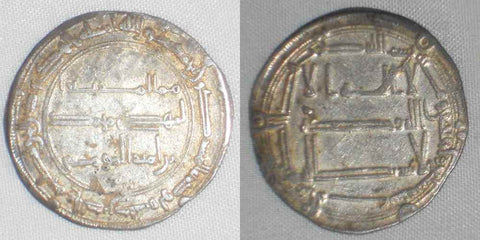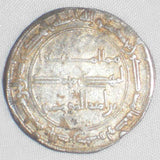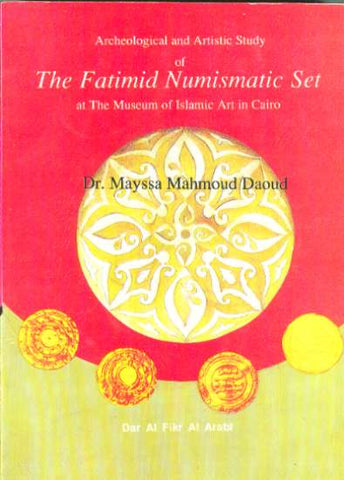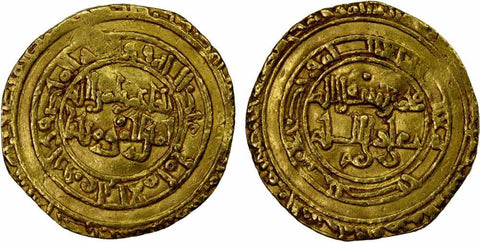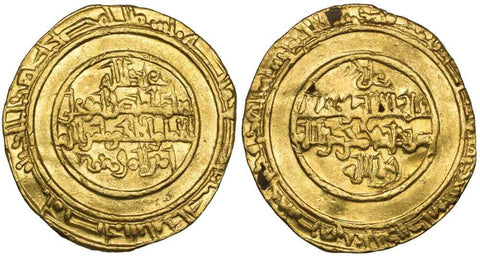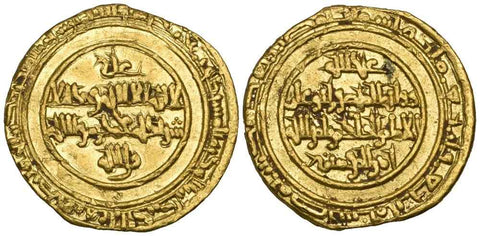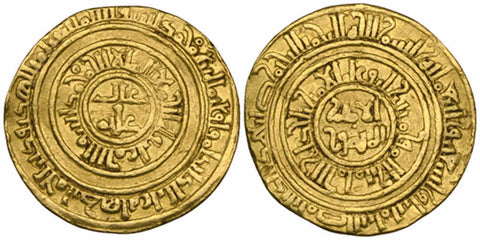Islamic Coin Al-Rayy Abbasid Silver Dirham Al-Mansur Citing Heir Al-Mahdi 147 AH
Description: Silver Dirham from Al-Mansur, who ruled the Muslim empire in the period 136-158 AH (754 - 775AD). Al-Mansur is the second caliph of the Abbasid dynasty. His full name being Abu Jafar Abdul Allah al-Mansur. This is a dirham, weighs ~2.9 grams and is ~25 mm in diameter. The coin shows the date of minting as 147 AH and the mint as al-Rayy. The obverse of the coin has the words "Mema Amr Beh al-Mahdi Mohammed Amir al-Mumini" with the words "Muhammad Rasul Allah, arsaluh bil huda wa din al haq liazharuh 'al al din kulh walaw karah al mushrikon" along the edge. The reverse shows the name of the mint and the date in a circle along the edge. It also has the words "La Illaha ell Allah, Wahduh la Sharik Lah" in the center. Al-Mahdi of course was al-Mansur's heir and is mentioned on the coin as such. Please note the coin is much better than the photos suggest with well-defined and legible calligraphy albite showing wear, scratches, and soiling throughout. Please carefully review the images presented as they part and parcel of our description.
Date: 147 AH or 764 AD.
Mint: Al-Rayy.
Size and weight: This is a dirham weighs ~2.9 grams and is ~25 mm in diameter.
References: It is Album #213.2; it is listed in Al'Ush Catalog of Islamic coins preserved in the national museum of Qatar as number 1438 and it is Wilkes 377.
Condition: I would grade this coin as a good fine or better. The coin has readable calligraphy albite showing, scratching, and soiling in the fields throughout. The coin has considerable wear, soiling in the field especially on the obverse, some residual soil embedded in the calligraphy and around it. The coin shows wear to the inscription, but it is still readable. Be that as it may the coin is very nice and would make a nice addition to your collection. Please note the coin itself is better than the photos show with relatively well defined and legible calligraphy. Please see photos for additional condition information.
Historic Perspective: <p>Abbasid is an Arabic ruling dynasty, originally based in Madinat al-Salam (current day Baghdad) that expanded the Muslim empire and lasted from 750 Ad to 1258 AD. It was named for al-Abbas (566?-652), paternal uncle of the prophet Muhammad. ). Al-Safah leaded the revolt against the Umayyad established and became the first Abbasid Caliph upon the overthrow of the Umayyad caliph in 132 AH / 749 AD. During the first century of the Abbasid rule the empire experienced a time of unprecedented cultural, artistic and economic development, particularly during the reigns of Harun al-Rashid (786-809) and his son al-Ma’mun (813-833).
Date: 147 AH or 764 AD.
Mint: Al-Rayy.
Size and weight: This is a dirham weighs ~2.9 grams and is ~25 mm in diameter.
References: It is Album #213.2; it is listed in Al'Ush Catalog of Islamic coins preserved in the national museum of Qatar as number 1438 and it is Wilkes 377.
Condition: I would grade this coin as a good fine or better. The coin has readable calligraphy albite showing, scratching, and soiling in the fields throughout. The coin has considerable wear, soiling in the field especially on the obverse, some residual soil embedded in the calligraphy and around it. The coin shows wear to the inscription, but it is still readable. Be that as it may the coin is very nice and would make a nice addition to your collection. Please note the coin itself is better than the photos show with relatively well defined and legible calligraphy. Please see photos for additional condition information.
Historic Perspective: <p>Abbasid is an Arabic ruling dynasty, originally based in Madinat al-Salam (current day Baghdad) that expanded the Muslim empire and lasted from 750 Ad to 1258 AD. It was named for al-Abbas (566?-652), paternal uncle of the prophet Muhammad. ). Al-Safah leaded the revolt against the Umayyad established and became the first Abbasid Caliph upon the overthrow of the Umayyad caliph in 132 AH / 749 AD. During the first century of the Abbasid rule the empire experienced a time of unprecedented cultural, artistic and economic development, particularly during the reigns of Harun al-Rashid (786-809) and his son al-Ma’mun (813-833).

